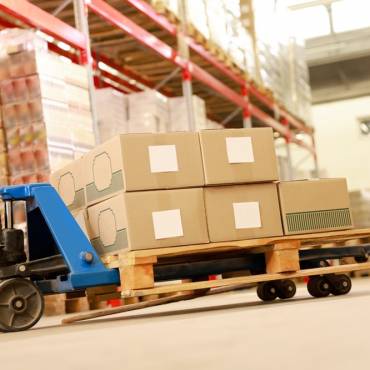Every business needs new ways to save money and time on their logistics approach. These days, one of the most popular approaches is a “just-in-time” (JIT) inventory model. A just in time inventory system helps many companies streamline their manufacturing process and save money, time, and storage space. That being said, the system isn’t without its drawbacks like vulnerabilities to supply chain disruptions.
Learn all about just-in-time inventory management below, along with the pros and cons of adopting a JIT approach in your supply chain.
What is just in time inventory management?
Just-in-time is an inventory management style that aims to deliver items as needed and keep existing inventory levels low. The JIT model dates back to the 1970s when it originated at a Japanese Toyota manufacturing plant. It draws on Japanese attitudes toward work, where everyone involved in production contributes to improving workflow and maximizing efficiency.
Just In Time (JIT) Examples
Toyota’s original JIT system works by building cars to order. For instance, managers time deliveries of components so that they arrive just before they’re needed on the assembly line. Think of it like cooking dishes to order at a restaurant.
That said, a JIT approach can be applied at any stage of the supply chain. For example, you can time the delivery of raw materials to arrive before they’re manufactured into parts, or for finished products to make it to a store just before they’re scheduled to hit shelves.
What companies use just in time inventory systems?
Just-in-time isn’t just for the automotive industry. However, many companies in other industries have successfully implemented JIT systems in their supply chains, including:
- Technology companies like Apple and Dell
- Large retail stores like Walmart and Target
- Clothing and apparel brands like Zara and Nike
What are the just in time inventory advantages and disadvantages?
A JIT inventory approach is designed to eliminate waste and maximize your efficiency. Nevertheless, it requires every part of your manufacturing process to stay in sync, making it vulnerable to supply disruptions or changes in customer demand. The following pros and cons can help you decide if a JIT strategy is right for your business.
JIT Pro: Save on storage costs
One of the major benefits of JIT is that JIT emphasizes keeping minimal inventory on hand, allowing you to decrease long-term warehouse storage fees. Since you’ll only order items when necessary, you won’t have an inventory backlog of wasted material. Particularly, if you deal in perishables, you can also avoid spoilage. This can help you keep your storage budget down and free up funds for other aspects of your business.
JIT Con: Vulnerable to disasters
Not all JIT systems are perfect and there are distinct disadvantages of JIT. For instance, global events, like the COVID-19 pandemic, or regional problems, like bad weather, can cause delays that may slow down or halt production. Shortages in parts or raw materials can also stress a JIT inventory model. In fact, a scenario like that happened at the original Japanese Toyota plant that pioneered the JIT strategy.
Importantly, in 1997, one of Toyota Japan’s key suppliers suffered a fire and couldn’t produce essential vehicle valves. There weren’t any alternative suppliers of the part, either. The delay and lack of inventory caused Toyota’s production to shut down, ultimately costing them 160 billion yen (over one billion dollars) in revenue.
JIT Pro: Maximize efficiency
By focusing solely on essential components, a JIT strategy strips away anything that doesn’t directly contribute to your goals. Therefore, you can eliminate unnecessary shipments and encourage better workflow.
Additionally, less inventory means you can free up internal storage areas in production facilities. For example, you can convert the space into workspaces to improve productivity.
JIT Con: Cust fluctuations
Heavily relying on logistics and suppliers could make your business vulnerable to price fluctuations in the market. For example, if a material shortage suddenly spikes prices, you may have to raise rates to keep up with the competition. This could leave you struggling to keep up with competitors who have emergency inventory on hand.
JIT’s dependence on smaller shipments could also cause you to miss out on bulk discounts for shipping.
JIT Pro: Coordinated staff
Since the JIT system relies on coordination between your suppliers and the production line, it means that all of your employees and business partners need to be on the same page. However, when done well, this can help you build better relationships with your partners. Your employees can also be more involved by identifying improvement opportunities during production.
JIT con: Difficult to scale
For a JIT system to work, you need to accurately predict consumer demand and ensure you’ll have the resources to meet it. If product demand suddenly increases, you might not have enough inventory on hand to meet it without delays. This could cause you to miss out on sales opportunities or stall production until new shipments can arrive.
JIT Supply Chains: Conclusion
For many companies, a JIT model can streamline your production process, save money, and make your entire supply chain run more efficiently. However, the system can also leave you vulnerable to fluctuations in supply, like shortages or increased demand. Only you can decide if the risks are worth the potential rewards for your business.
But if you’re ready to find a third-party logistics company to fulfill JIT contracts, N&D Transportation is ready to help. At our Rhode Island warehouse, we’re ready to ship important items at a moment’s notice, so you can meet fast JIT deadlines without skipping a beat. At the same time, we also offer competitive rates on storage space in our racked and heated warehouse so you can safely hold emergency inventory.
Contact us today to learn how we can boost your supply chain’s efficiency.



